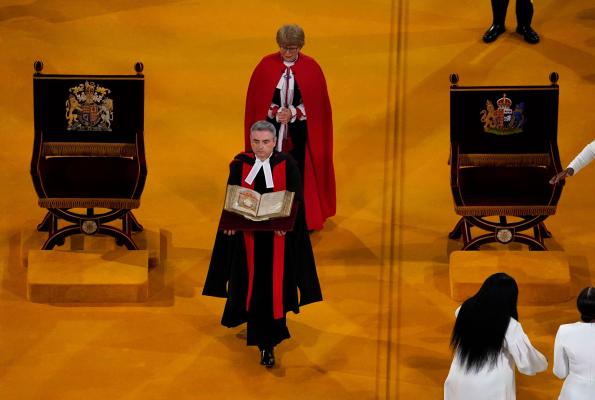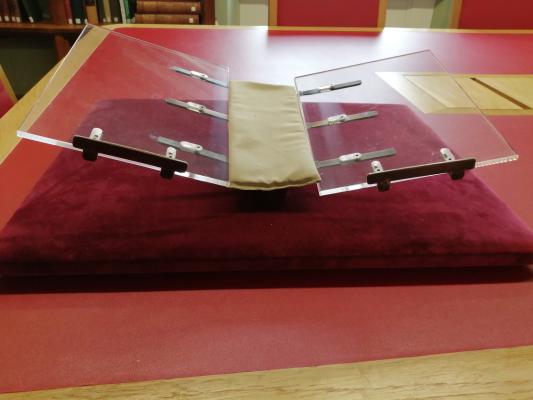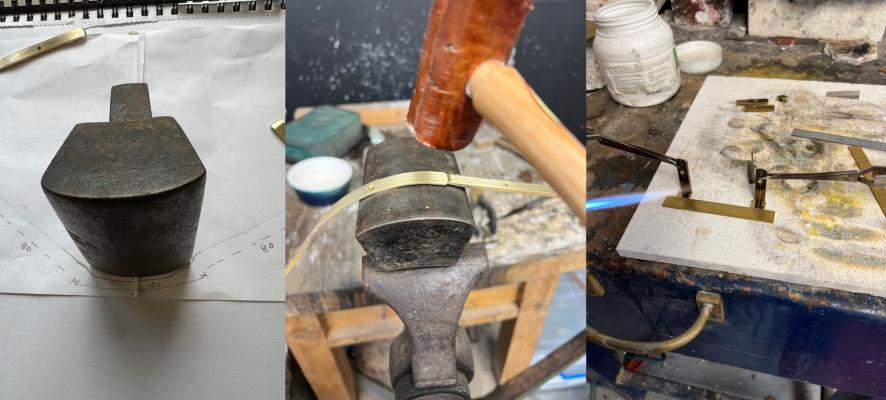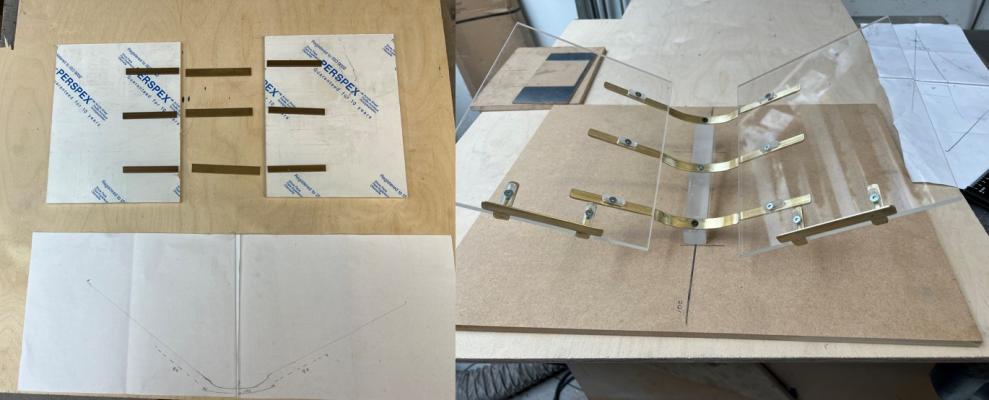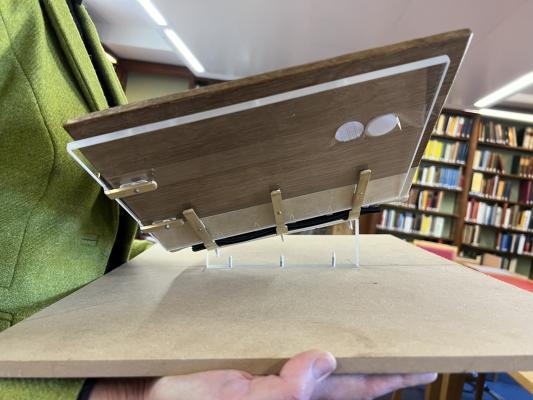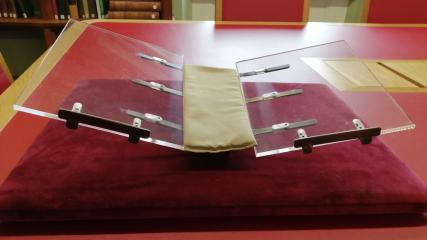Displaying the Augustine Gospels
What does it take to display a priceless and unique historical object in a modern televised event? We at the Parker Library had to take this question seriously when we were asked to lend one of the most precious items in our collections: the Augustine Gospels for the Coronation of King Charles III.
The Gospels made the longer journey from the Parker Library to Westminster and back in a closed, padded and rigid box. But for a short journey inside Westminster Cathedral, the Augustine Gospels rested on a comfortable cradle, designed to present the best view of the full manuscript while not compromising its safety.
Professor Christopher Kelly, Master of Corpus Christi College Cambridge, walking down the Westminster aisle with the Augustine Gospels, which are open to the page featuring a portrait of Luke the Evangelist (CCCC MS 286 ff. 129v-130r).
Here are some of the behind-the-scenes work and planning that went into the 25-minute walk of fame during the Coronation.
Completed display mount for the Augustine Gospels, as used in the Coronation of King Charles III.
The mount in the making
The building of the specialist mount exhibiting the Augustine Gospels was entrusted to Colin Bowles of Colin Bowles Ltd; he was also responsible for all the other display mounts for the Coronation objects. Right from the start it was clear that the stability and security of the object had to be balanced with a pursuit for minimal aesthetic intrusion. The manuscript had to be as visible as possible, but at the same time it had to be fully secure while the Master of Corpus Christi College Cambridge, Professor Christopher Kelly, processed it down the aisle of Westminster Abbey.
Getting the hardware ready for the mount: the mold for the curvature of the middle section of the support, hammering the shape, and soldering the solid seams. Images with the kind permission of Colin Bowles.
The mount was built with reusability and versatility in mind. Two acrylic leaves are joined together with three specially formed three-part brass-sections soldered together. If the mount were to have been one solid piece of acrylic, it would become brittle after 30 years. The benefit of the present design is that the acrylic will last a few hundred years as it is not under stress, while the brass continues to be workable. In addition, the template makes it possible to replace the acrylic if needed. The support leaves can be adjusted to optimally support the sine and the open cover of the manuscript by screws in elongated screw holes.
The mount in progress showing the adjustable brass sections. Images with the kind permission of Colin Bowles.
There is nothing on the mount that will compromise the book even if it were to be exhibited on it in a closed environment. The core material is inert European good-quality birch plywood with minimal off-gassing of volatile organic compounds. The upholsterer staple-fixed silk velvet fabric that was used for all the exhibition panels. The 30mm acrylic block which functions as a single leg was cut to a 12-degree display angle considered optimal to alleviate stress on the binding of the manuscript.
Earthquake proofing
Some sharp-eyed observers of the Gospel procession would have noticed some wobbling movement of the Gospels while the Master was walking. This was a purposeful design feature, reminiscent of earthquake-proofing of object displays. While it is true that upright supports to the acrylic leaves would have been possible to make the display completely rigid, it was considered better to allow the energy of the existing movement (act of walking) to find an escape route so that it was not contained in the manuscript. Though the manuscript was not suspended per se, the mounting allowed a controlled marginal movement.
Strapping
Two straps were prepared to ensure the manuscript remained open in the correct position throughout the coronation. The Head of the Cambridge Colleges' Conservation Consortium, Flavio Marzo, designed and prepared polyethylene straps which stabilized the opening. Polyethylene was chosen instead of archival grade polyester (Melinex) because it is less reflective and therefore produced less glare for the cameras. It is also softer on the Gospels.
Testing the mount with the Augustine Gospels in place. The underside view of the design shows the trial polyethylene straps with white Velcro roundels.
The straps were fitted with white Velcro roundels which were attached and fastened to the straps themselves. The straps were then wrapped around the cover boards. This was done to prevent the marginal movement of the mount from causing any damage to the manuscript. If the straps had been attached directly to the acrylic support, the ‘wobbling’ of the support could have transferred to the surface of the manuscript, potentially resulting in abrasions. As the straps were secured around the manuscript boards only, they didn’t move even when the mounting cradle was moving. In addition, the Velcro straps made it easy to open the Gospels just before they made their appearance since they could be maneuvered by one person only. Equally, it was safe to remove the straps quickly and lift the book from the display to its Phase box (archival box) when the book was returned for safekeeping to the Fellow Librarian Dr Philippa Hoskin.
Materials used:
Support: three brass-strips, two acrylic leaves, nine stainless steel machine screws, two brass tabs that engage the tail-edge, secured on the bottom of the wings with 4 stainless steel machine screws. Underside: 1 acrylic block for 12-degree display angle, sprayed red and anchored with 3 screws to birch plywood base, 400 x 520mm, covered in silk velvet. All screws with 4mm standard thread. Two polyethylene straps with Velcro roundels.
Special thanks to: Mountmaker: Colin Bowles; Upholsterer: Roman Szokalski; Straps: Head of Conservation Flavio Marzo; and to the Master of Corpus Christi College Cambridge Professor Christopher Kelly, Fellow Librarian Dr Philippa Hoskin, Sub-Librarian Tuija Ainonen, Head of Communications Fiona Gilsenan, Archivist Genny Silvanus.
Follow us on Twitter @ParkerLibCCCC

